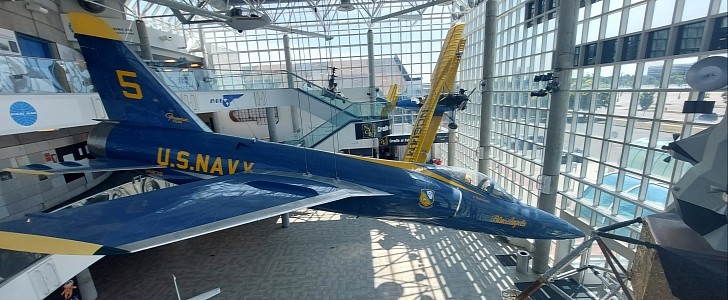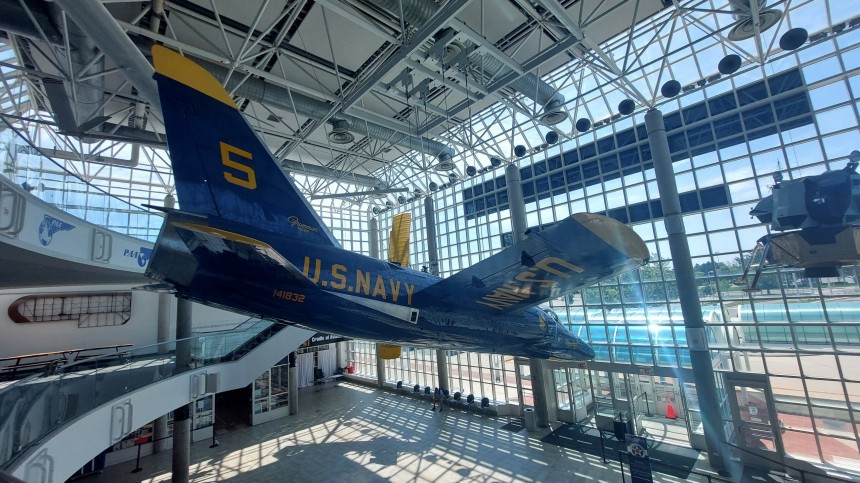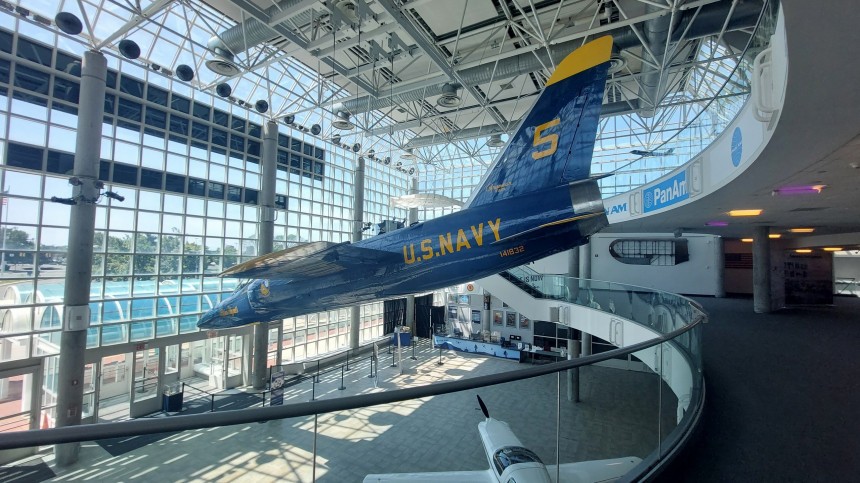Grumman was the U.S. Navy's go-to carrier-based fighter plane manufacturer since before the days of World War II. But not every airframe the Long Island-based aerospace firm built went on to have a legendary career full of amazing stories of durability and overwhelming firepower. Some simply fizzled out into nothing after only a short while.
This was the case with the Grumman F-11 Tiger. Less well known than the F9F Panther/Cougar that came before it and utterly overshadowed by the deadly and beautiful F-14 Tomcat, the Tiger was a project that looked hopeful in the beginning but turned out to be something Grumman probably wanted to forget ever happened by its end.
In the beginning, the F-11 had its genesis as an experimental, privately funded design study to try and upgrade Grumman's older F9 Cougar naval fighter. A very capable and deadly jet in its own right, but starting to appear somewhat outmatched by faster, deadlier Soviet jet fighters it was liable to face off against in hypothetical late 50s or early 60s Cold War gone hot. Jets like the Sukhoi Su-7 and Su-9, Mikoyan-Gurevich MiG 17, MiG-19, and eventually the MiG-21.
All of these jets could easily body and an entire squadron of Cougars with sufficiently trained pilots at the stick. Something better was surely needed if the U.S. Navy was to stick with Grumman as its primary jet fighter supplier. What resulted was a prototype initially referred to as the YF9F-9. But when it became apparent the new airframe would be profoundly different from the Cougar family, a company designation of G-98, and then an official moniker of F-11 Tiger was selected.
In nearly every way, the Tiger was a vast improvement over the Cougar. Light, agile, and capable of supersonic speeds, the Tiger's single Wright J65-W-18, a license-built copy of the Armstrong-Siddeley Sapphire afterburning turbojet, pumped out 7,450 lbf (33.1 kN) of thrust at full throttle and over 10,500 lbf (47 kN) with full afterburner. Suitable for a top speed of around 730 miles per hour (1,169 km/h, Mach 1.1) at cruising altitude and slightly less at sea level.
With upgraded leading edge slats, a fully redesigned wing, and spoilers that flapped up and down to control roll rates instead of ailerons, the Tiger was profoundly different not only from the now-defunct Grumman Cougar but also from any other navy fighter in the skies at the time. Initial test trials for the Tiger seemed promising, with excellent acceleration, maneuverability, and visibility reported by both Grumman and Navy test pilots.
Even as an afterburning variant of the Wright J-65 languished in development, tests with that engine with the afterburner not present still yielded somewhat positive results during its first at-sea trials aboard the USS Forrestall supercarrier in April 1956. Later that year, on September 21st, all that promising potential would begin to come crashing down thanks to a remarkably bizarre incident still talked about in aviation circles nearly 70 years later.
On this day, Navy pilot Tom Attridge was piloting a Tiger during a routine test of its four Colt Mk 12 autocannons over Long Island, New York. These were phenomenal pieces of armament. Powerful, with good spread, range, and recoil characteristics. But on this flight, Attridge's Tiger entered a steep dive and fired two short bursts from his quad cannons. As the Tiger gained more speed and as the trajectory of the cannon fire petered out, the aircraft and stream of bullets inexplicably met at a point in the sky and collided.
Now stricken by a barrage of fire from his own cannons, Attridge was able to crash land and survive. Even in the world of pre-social media, news of this frankly embarrassing and, as far as we know, unprecedented accident at this time rendered the once-promising supersonic navy jet fighter into little more than a big joke, or a dank meme, as the kids say nowadays.
A concept jet with a larger General Electric J79 engine called the F-11F-1F Super Tiger did little to boost the public perception of a jet that literally shot itself down before it ever got a chance to shoot at a MiG it was intended to destroy. Considering both the F4 Phantom II and F8 Crusader were already on the scene by this point, there simply wasn't room for Tigers on American flight decks anymore.
Instead, the type was retired from carrier service after a pitiful four years in 1961. It lingered on as a trainer for a few years more but ultimately found its greatest success not in combat but in service with the Blue Angels acrobatics squadron. There, it would serve until 1969, almost surviving to see the deployment of the F-14 Tomcat, the jet that would ultimately replace it in the Grumman "Big Cat" naval fighter lineage.
Today, you can find a genuine Blue Angels F-11 Tiger hanging from the main lobby of the Cradle of Aviation Museum in Garden City, New York, as well as a few other places. In its stunning blue and yellow paint scheme, and despite all its flaws, one can't deny it's one heck of a good-looking airplane.
In the beginning, the F-11 had its genesis as an experimental, privately funded design study to try and upgrade Grumman's older F9 Cougar naval fighter. A very capable and deadly jet in its own right, but starting to appear somewhat outmatched by faster, deadlier Soviet jet fighters it was liable to face off against in hypothetical late 50s or early 60s Cold War gone hot. Jets like the Sukhoi Su-7 and Su-9, Mikoyan-Gurevich MiG 17, MiG-19, and eventually the MiG-21.
All of these jets could easily body and an entire squadron of Cougars with sufficiently trained pilots at the stick. Something better was surely needed if the U.S. Navy was to stick with Grumman as its primary jet fighter supplier. What resulted was a prototype initially referred to as the YF9F-9. But when it became apparent the new airframe would be profoundly different from the Cougar family, a company designation of G-98, and then an official moniker of F-11 Tiger was selected.
In nearly every way, the Tiger was a vast improvement over the Cougar. Light, agile, and capable of supersonic speeds, the Tiger's single Wright J65-W-18, a license-built copy of the Armstrong-Siddeley Sapphire afterburning turbojet, pumped out 7,450 lbf (33.1 kN) of thrust at full throttle and over 10,500 lbf (47 kN) with full afterburner. Suitable for a top speed of around 730 miles per hour (1,169 km/h, Mach 1.1) at cruising altitude and slightly less at sea level.
Even as an afterburning variant of the Wright J-65 languished in development, tests with that engine with the afterburner not present still yielded somewhat positive results during its first at-sea trials aboard the USS Forrestall supercarrier in April 1956. Later that year, on September 21st, all that promising potential would begin to come crashing down thanks to a remarkably bizarre incident still talked about in aviation circles nearly 70 years later.
On this day, Navy pilot Tom Attridge was piloting a Tiger during a routine test of its four Colt Mk 12 autocannons over Long Island, New York. These were phenomenal pieces of armament. Powerful, with good spread, range, and recoil characteristics. But on this flight, Attridge's Tiger entered a steep dive and fired two short bursts from his quad cannons. As the Tiger gained more speed and as the trajectory of the cannon fire petered out, the aircraft and stream of bullets inexplicably met at a point in the sky and collided.
Now stricken by a barrage of fire from his own cannons, Attridge was able to crash land and survive. Even in the world of pre-social media, news of this frankly embarrassing and, as far as we know, unprecedented accident at this time rendered the once-promising supersonic navy jet fighter into little more than a big joke, or a dank meme, as the kids say nowadays.
Instead, the type was retired from carrier service after a pitiful four years in 1961. It lingered on as a trainer for a few years more but ultimately found its greatest success not in combat but in service with the Blue Angels acrobatics squadron. There, it would serve until 1969, almost surviving to see the deployment of the F-14 Tomcat, the jet that would ultimately replace it in the Grumman "Big Cat" naval fighter lineage.
Today, you can find a genuine Blue Angels F-11 Tiger hanging from the main lobby of the Cradle of Aviation Museum in Garden City, New York, as well as a few other places. In its stunning blue and yellow paint scheme, and despite all its flaws, one can't deny it's one heck of a good-looking airplane.









